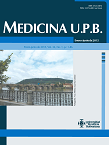Incontinencia urinaria en un grupo de personas vinculadas con el programa de adultos mayores del municipio de Sabaneta, Colombia
Contenido principal del artículo
Resumen
Objetivo: determinar la prevalencia de Incontinencia urinaria (IU) en un grupo de adultos mayores del municipio de Sabaneta, Colombia e identificar factores de riesgo, características clínicas y prácticas de autocuidado.
Metodología: se desarrolló un estudio Cross Sectional. Se aplicó una encuesta a una muestra de 123 adultos mayores que hacen parte del programa que tiene el municipio para esta población. La información se procesó en SPSS versión 17 y tuvo un análisis descriptivo. Para identificar los factores de riesgo se calculó el OR como medida de asociación, con sus respectivos intervalos de confianza al 95%, se asumió significancia estadística si el valor de p era menor de 0.05.
Resultados: la prevalencia de IU encontrada fue del 25.2%; el 38.7% la clasificó como IU de esfuerzo, el 32.3% de urgencia y el 29.0% mixta. Los factores de riesgo que presentaron significancia estadística fueron: infecciones urinarias y vaginales frecuentes y antecedente familiar de IU. Al 29.0% la IU le genera irritación de la piel y al 19.4% sentimientos de inferioridad. Los cuidados que más aplican son: uso de ropa cómoda (64.5%) y empleo de paños absorbentes (54.8%). El 71.0% no ha consultado al médico por este motivo.
Conclusiones: se evidenció alta frecuencia del problema, tolerancia pasiva y repercusión en la calidad de vida, lo cual muestra la necesidad de ahondar sobre el tema para orientar mejor el cuidado por parte del personal de salud.
Referencias
Robles J. La incontinencia urinaria. An Sist Sanit Navar [Internet] 2006 [fecha de acceso 17 de mayo de 2014]; 29 (2): 219-223. Disponible en: http://scielo.isciii.es/pdf/asisna/v29n2/revision2.pdf
Ballester A, Mínguez M, Herreros B, Hernández V, Sanchiz V, Benages A. Prevalence of silent fecal and urinary incontinence in women from the town of Teruel. Rev Esp Enferm Dig [Internet] 2005 [fecha de acceso 17 de mayo de 2014];97(2): 78-86. Disponible en: http://scielo.isciii.es/pdf/diges/v97n2/original1. pdf
Dios J, Rodríguez M, Martínez J, Rodríguez C, Melero M, García J. Prevalencia de la incontinencia urinaria en personas mayores de 64 años en Galicia. Gac Sanit [Internet]. 2003 [fecha de acceso 17 de mayo de 2014];17(5): 409-411. Disponible en: http://scielo.isciii.es/pdf/gs/v17n5/breve2.pdf
Higa R, Lopes M, Turato E. Significados psico-culturales para la incontinencia urinaria femenina: Una revisión. Rev Latino-am Enfermagem [Internet] 2008 [fecha de acceso 17 de mayo de 2014];16(4):779- 786. Disponible en: http://www.scielo.br/pdf/rlae/v16n4/es_20.pdf
García H, López H, Carbonell J, Castillo D. Impacto de la incontinencia urinaria sobre la salud sexual femenina. urol.colomb [Internet] 2010 [fecha de acceso 17 de mayo de 2014];19(3): 59-67. Disponible en: http://www.urologiacolombiana.com/userfiles/file/diciembre10/8/7-%20Incontinencia%20urinaria%20 y%20salud%20sexual%20femenina.pdf
Silva V, D’elboux MJ. Fatores associados à incontinência urinária em idosos com critérios de fragilidade. Texto contexto - enferm. [Internet] 2012 [fecha de acceso 17 de mayo de 2014];21(2): 338-347. Disponible en: http://www.scielo.br/scielo.php?script=sci_arttext&pid=S0104-07072012000200011&lng=en&nrm =iso
Lopes MH, Higa R. Restrições causadas pela incontinência urinária à vida da mulher. Rev. esc. enferm. USP [Internet] 2006 [fecha de acceso 17 de mayo de 2014];40(1): 34-41. Disponible en: http://www.scielo. br/scielo.php?script=sci_arttext&pid=S0080-62342006000100005&lng=en
Martínez L, Nellen H, Hamui A, Halabe J. Incontinencia urinaria en el adulto mayor. Rev Med Inst Mex Seguro Soc [Internet] 2007 [fecha de acceso 17 de mayo de 2014];45(5): 513-521 Disponible en: http:// www.medigraphic.com/pdfs/imss/im-2007/im075n.pdf
Teunissen D, Van den Bosch W, Van Weel C, Lagro-Janssen T. Urinary incontinence in the elderly: attitudes and experiences of general practitioners. A focus group study. Scand J Prim Health Care [Internet]. 2006 [fecha de acceso 17 de mayo de 2014];24(1): 56-61. Disponible en: http://www.ncbi.nlm.nih.gov/ pubmed/16464816
Viegas K, Welfer M, Denes G, Cardenaz C, Lara BR, da Silva A, et al. Qualidade de vida de idosos com incontinência urinária. Revista Ciência & Saúde [Internet] 2009 [fecha de acceso 17 de mayo de 2014];2(2): 50-57. Disponible en: http://revistaseletronicas.pucrs.br/ojs/index.php/faenfi/article/view/6388
Mourão F, Lopes L, Vasconcellos N, Almeida M. Prevalência de queixas urinárias e o impacto destas na qualidade de vida de mulheres integrantes de grupos de atividade física. Acta Fisiátr. [Internet] 2008 [fecha de acceso 17 de mayo de 2014];15(3): 170-175. Disponible en: http://www.actafisiatrica.org.br/ detalhe_artigo.asp?id=139
Silva V, D’Elboux MJ. Atuação do enfermeiro no manejo da incontinência urinária no idoso: uma revisão integrativa. Rev Esc Enferm. USP [Internet] 2012 [fecha de acceso 17 de mayo de 2014];46(5): 1221-1226. Disponible en: http://www.scielo.br/scielo.php?script=sci_arttext&pid=S0080- 62342012000500026&lng=en


